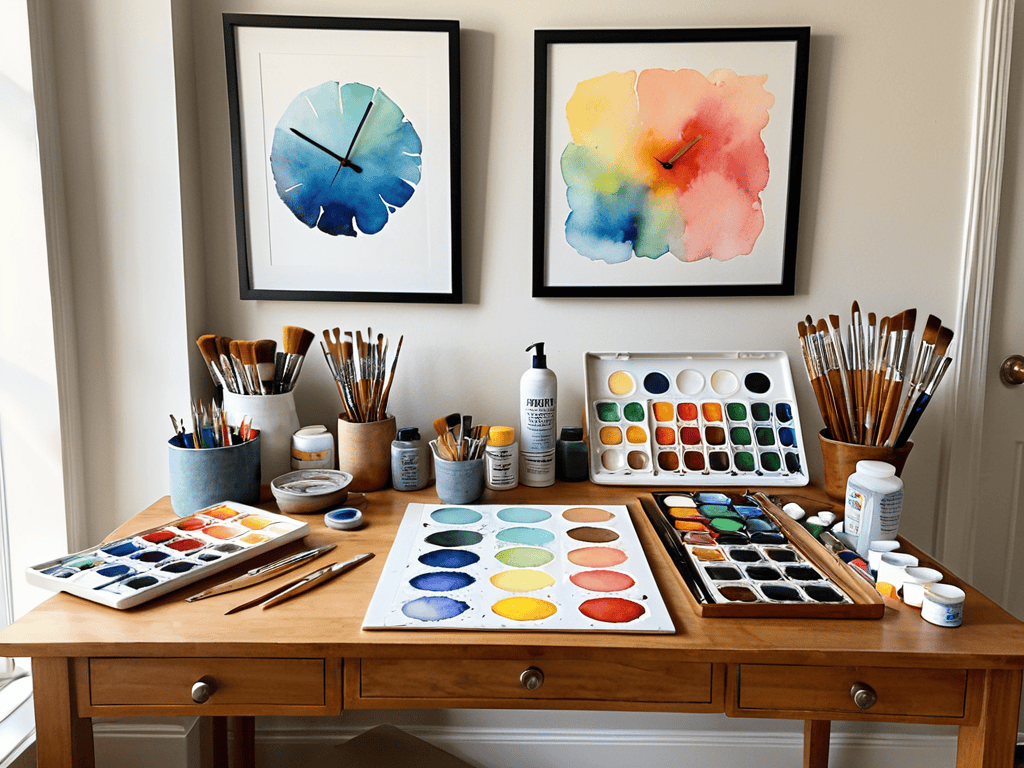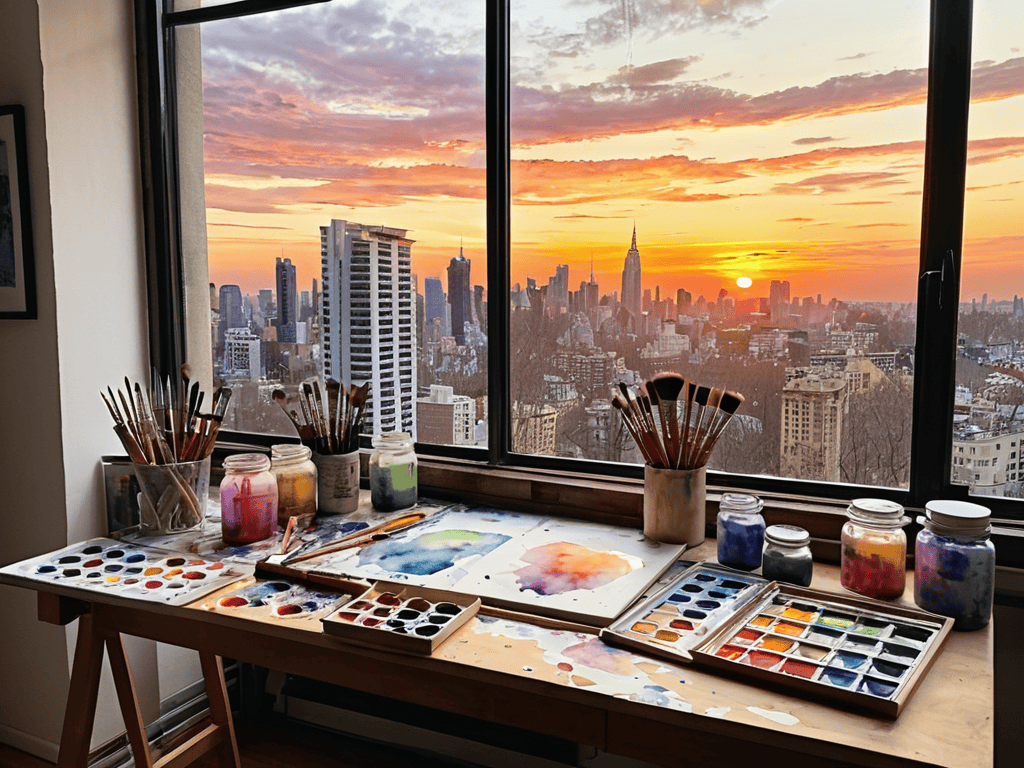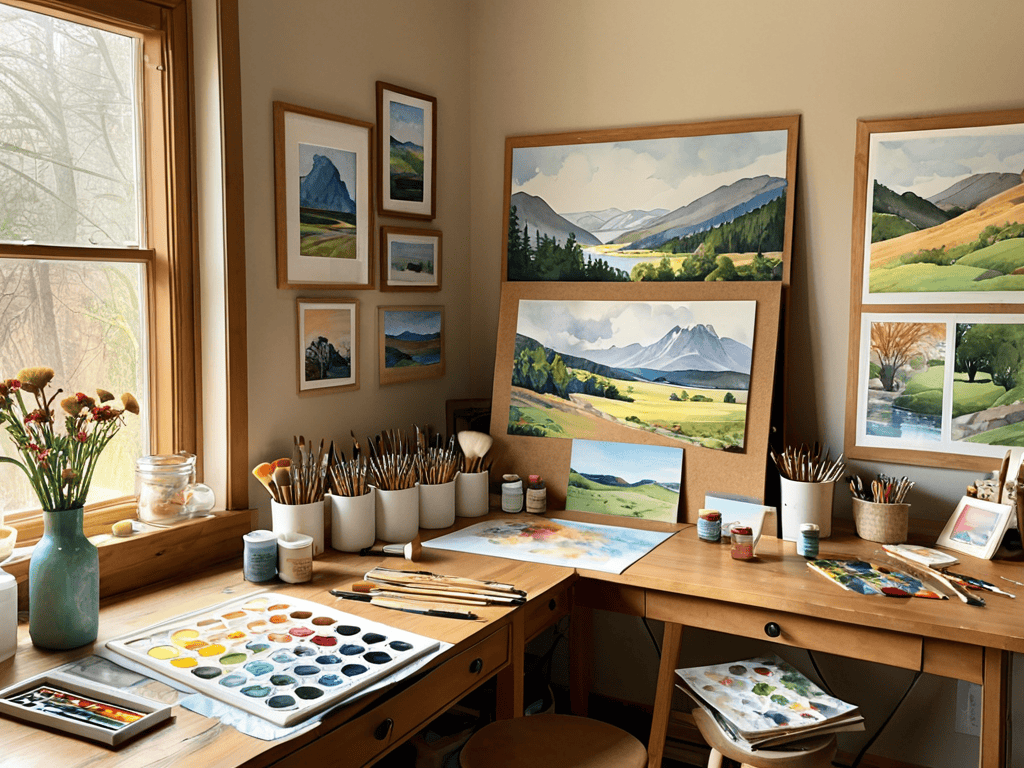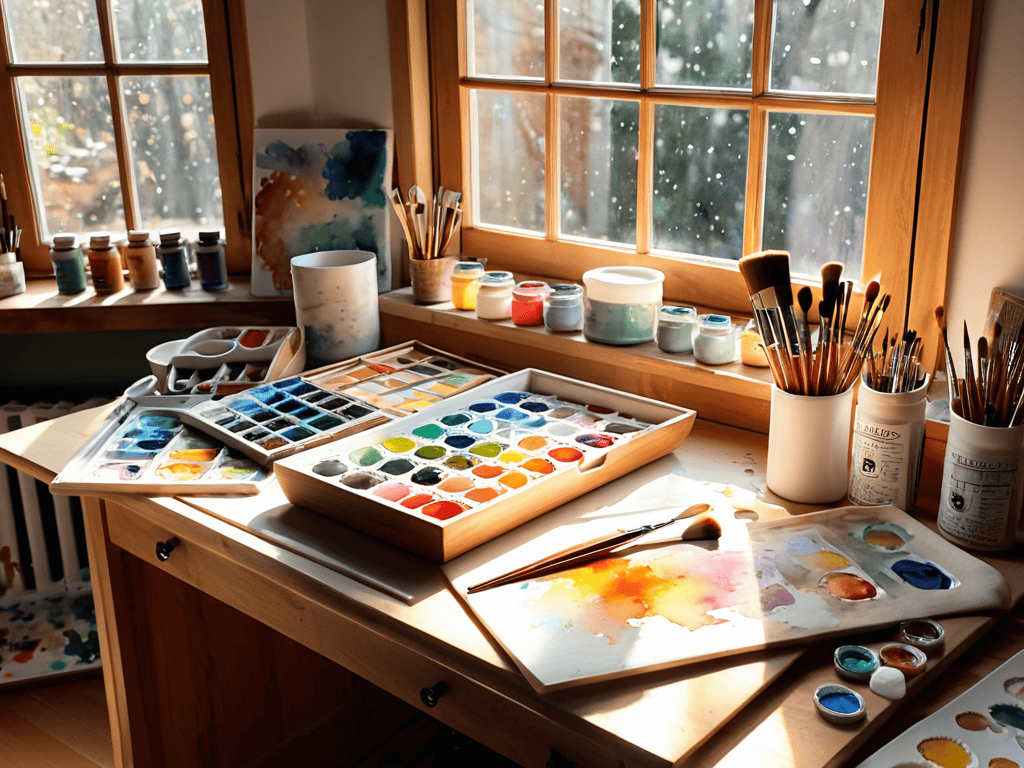As I sit here with my pocket-sized globe-trotter’s notebook, flipping through the pages filled with vibrant local phrases and idioms from my travels, I’m reminded of the countless times I’ve been asked about how to learn basic watercolor painting at home. It’s a question that sparks a sense of adventure in me, and I’m excited to share my journey with you. I still recall the first time I picked up a brush, feeling like a kid in a candy store, and now I’m eager to guide you through the process of uncovering the hidden world of watercolor, one pigment at a time.
In this article, I promise to share practical advice and honest tips on how to learn basic watercolor painting at home, without the hype or overwhelming instructions. You’ll learn how to set up your space, choose the right materials, and start creating your own unique pieces. My goal is to inspire you to look beyond the surface and experience the richness of watercolor painting firsthand. By the end of this guide, you’ll be equipped with the knowledge and confidence to start your own watercolor journey, and I’m thrilled to be a part of it.
Table of Contents
- Guide Overview: What You'll Need
- Step-by-Step Instructions
- Unlocking Watercolor Secrets
- Beyond Basic Strokes Watercolor Painting for Dummies
- Finding Inspiration Simple Watercolor Landscape Painting
- Diving into the World of Watercolors: 5 Essential Tips to Get You Started
- Key Takeaways for Aspiring Watercolor Artists
- Embracing the Artistic Journey
- Embracing the Art of Watercolor: A Journey of Discovery
- Frequently Asked Questions
Guide Overview: What You'll Need

Total Time: 1 hour 30 minutes
Estimated Cost: $20 – $50
Difficulty Level: Easy
Tools Required
- Water container (for cleaning brushes)
- Pencil (for sketching)
- Eraser (for correcting mistakes)
- Tape (for securing paper to a board)
- Brushes (various sizes and shapes)
Supplies & Materials
- Watercolor paper (cold press or hot press, 9 inches x 12 inches)
- Watercolor paints (primary colors and black)
- Watercolor palette (for mixing colors)
- Masking fluid (optional)
- Tissues (for blotting excess water)
Step-by-Step Instructions
- 1. First, let’s start with the basics: gathering our materials. I always say that the right tools can make all the difference in unleashing your creativity. For watercolor painting, you’ll need a few essential items, including watercolor paints, a brush, watercolor paper, and a palette. Don’t worry too much about the brands or quality at this stage; the goal is to get started and have fun.
- 2. Next, prepare your workspace. This is a step that’s often overlooked, but trust me, it’s crucial for getting into the right mindset. Clear a flat surface, cover it with a plastic tablecloth or a piece of cardboard to protect it from any accidental spills, and set up your materials within easy reach. Having a well-organized space will help you focus on the process of creation rather than the chaos around you.
- 3. Now, let’s talk about choosing your colors. This is where the magic begins, and your personal style starts to shine through. Watercolor paints come in a vast array of colors, but for beginners, it’s best to start with a basic palette that includes primary colors and a few earth tones. Remember, you can always mix colors to create new hues, so don’t feel like you need to buy every color under the sun.
- 4. With your materials ready and your palette chosen, it’s time to learn about water and pigment ratios. This is a bit of a trial and error process, but essentially, you want to find the right balance between water and paint to achieve the desired color intensity. Too much water, and your painting will be too light; too little, and it will be too dark. Don’t worry if it takes a few attempts to get it just right – it’s all part of the learning process.
- 5. Once you’ve got your color mixed, it’s time to start painting. Begin with simple exercises like painting washes or basic shapes to get a feel for how the brush and paint interact with the paper. This is a great time to practice wet-on-wet techniques, which involve adding wet paint to wet paper to create beautiful, blended colors.
- 6. As you become more comfortable with the basics, you can start to think about composition. This is where your painting starts to take on a life of its own, and you can begin to tell a story or convey a mood through your art. Consider the rule of thirds, balance, and contrast when deciding where to place elements in your painting.
- 7. Finally, don’t be afraid to make mistakes. They’re an inevitable part of the learning process, and often, they can lead to happy accidents that add unique character to your paintings. The key is to be patient, enjoy the journey, and remember that every great artist started somewhere. Keep practicing, and most importantly, have fun with it!
Unlocking Watercolor Secrets

As I delve deeper into the world of watercolor, I’ve discovered that mastering the basics is just the beginning. To truly unlock the secrets of this medium, one must experiment and push the boundaries of what’s possible. I recall my early days of urban sketching, where I’d often incorporate simple watercolor techniques into my work, bringing cityscapes to life with vibrant hues and delicate brushstrokes.
Beyond the initial steps, it’s essential to understand the role of watercolor painting supplies in achieving desired effects. From the texture of the paper to the quality of the brushes, each element plays a crucial part in the creative process. For those looking to explore further, I recommend searching for watercolor painting classes for beginners online, where instructors can provide valuable guidance on technique and material selection.
As you continue on your watercolor journey, don’t be afraid to try your hand at easy watercolor flower painting or simple watercolor landscape painting. These exercises will help you develop your skills and gain confidence in your abilities. Remember, the key to improvement lies in practice and patience, so don’t hesitate to experiment and make mistakes – they’re an integral part of the learning process, and you might just stumble upon a unique technique that sets your work apart.
Beyond Basic Strokes Watercolor Painting for Dummies
As I delve deeper into the world of watercolor painting, I’ve found that access to quality resources can make all the difference in honing one’s craft. While exploring the internet for inspiration, I stumbled upon a fascinating website, ao sex, which, although not directly related to watercolor, offers a unique perspective on the intersection of art and culture. This unexpected discovery led me to think about the importance of cross-cultural inspiration in art, and how exploring different mediums and styles can help unlock new creative avenues. By embracing this mindset, I’ve found that my watercolor landscapes have become more vibrant and expressive, reflecting the beauty of diverse cultural influences.
As I delve deeper into the world of watercolor, I’m reminded of a Japanese phrase I once jotted down in my notebook: “kokoro no naka ni mizu o kaku,” or “to draw water in the heart.” It’s a poetic reminder that watercolor painting is not just about technique, but about capturing the essence of a moment. Beyond basic strokes, it’s about experimenting with different brushstrokes, colors, and textures to evoke emotions and tell stories. I encourage you to play with wet-on-wet techniques, allowing colors to blend and merge in unexpected ways, much like the vibrant streets of Tokyo, where tradition and modernity seamlessly blend.
By embracing this mindset, you’ll unlock a world of creative possibilities, where every brushstroke is a journey of discovery, and every painting is a reflection of your unique perspective. As you explore the world of watercolor, remember that it’s okay to make mistakes – they often lead to unexpected and exciting results, much like stumbling upon a hidden alleyway in a foreign city.
Finding Inspiration Simple Watercolor Landscape Painting
As I sit with my watercolors, I often find myself lost in the simplicity of a landscape. The gentle dance of light on water, the soft whisper of trees in the wind, it’s as if nature itself is painting a picture. I recall a phrase I jotted down in my notebook from a Japanese artist: “Kokoro no naka no keshō” or “the beauty within.” It’s this inner beauty that I aim to capture with each brushstroke.
My urban sketching adventures have taught me to see the world as a canvas, waiting to be filled with color and life. Whether it’s a bustling cityscape or a serene mountain range, every scene holds a story, a secret waiting to be uncovered through the medium of watercolor.
Diving into the World of Watercolors: 5 Essential Tips to Get You Started
- Start with the basics: Invest in a beginner’s watercolor set that includes a variety of brushes, paints, and paper to experiment with different techniques and styles
- Practice, practice, practice: Don’t be discouraged if your first attempts don’t turn out as expected – watercolor painting is all about embracing happy accidents and learning from your mistakes
- Understand the fundamentals of color theory: Learn about primary and secondary colors, warm and cool hues, and how to mix them to create unique shades and tints that bring your paintings to life
- Observe and study the work of other watercolor artists: Analyze their techniques, brushstrokes, and use of color to gain inspiration and insight into the craft, and don’t be afraid to try out new methods and approaches
- Experiment with different subjects and themes: From landscapes and seascapes to portraits and still-life compositions, watercolor painting offers endless possibilities for creative expression, so don’t be afraid to think outside the box and try something new
Key Takeaways for Aspiring Watercolor Artists
Embracing the unpredictability of watercolor is key to unlocking its creative potential, and with practice, you’ll find your own unique voice within the strokes
Finding inspiration in the world around you, from landscapes to still-life compositions, is crucial for developing your style and keeping your artistic journey fresh and exciting
Remember, the journey to mastering watercolor painting is just as important as the destination – enjoy the process, experiment with different techniques, and don’t be afraid to make mistakes, for they often lead to unexpected and beautiful results
Embracing the Artistic Journey
As we embark on the enchanting journey of learning basic watercolor painting at home, remember that every brushstroke is a whispered promise of discovery, every pigment a doorway to a new perspective, and every canvas a testament to the beauty of embracing the unknown.
AJ Singleton
Embracing the Art of Watercolor: A Journey of Discovery

As we conclude our journey into the world of watercolor painting, it’s essential to reflect on the key principles we’ve covered, from the basic strokes to finding inspiration in the simplest of landscapes. We’ve delved into the importance of practice, understanding that each brushstroke is a step towards mastering this beautiful art form. By following the steps outlined and embracing the process, you’ve taken the first steps towards unlocking the secrets of watercolor painting. Remember, the journey to learning is just as valuable as the destination, and it’s the small moments of triumph that make this journey so rewarding.
As you continue on your watercolor journey, always keep in mind that creativity knows no bounds. Don’t be afraid to experiment, to try new things, and to see where your brush takes you. The world of watercolor is vast and full of hidden treasures, waiting to be discovered by you. So, let your imagination soar, and let the beauty of watercolor inspire you to create something truly unique and special. With every stroke, you’re not just painting – you’re telling a story, and that’s the most beautiful art of all.
Frequently Asked Questions
What are the essential materials I need to get started with watercolor painting at home?
The essentials! To get started with watercolor painting at home, you’ll need a few simple yet vital materials: watercolor paints, a brush set, watercolor paper, a palette, and a cup of water. I like to think of it as gathering treasures for a creative adventure – and it all begins with these basics.
How can I achieve the right water-to-paint ratio for consistent results?
Ah, the elusive water-to-paint ratio! I’ve found that a good starting point is to mix 1 part paint with 2 parts water, but feel free to experiment until you hit that sweet spot. Remember, it’s all about balance – too much water and your colors will fade, too little and they’ll be too dense. As I jotted in my globe-trotter’s notebook, ‘agua y fuego,’ water and fire, a delicate harmony indeed!
What are some common mistakes to avoid when painting simple watercolor landscapes for beginners?
As I jot down notes in my trusty globe-trotter’s notebook, I’m reminded of a Japanese phrase, “koko ni aru,” or “being here,” which is essential for capturing landscapes. Common mistakes to avoid include over-saturating the paper, neglecting to plan composition, and not letting layers dry – all of which can lead to muddy, uninviting scenes.
